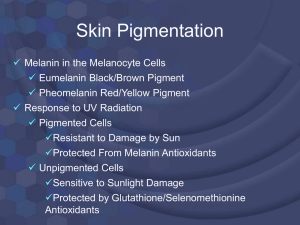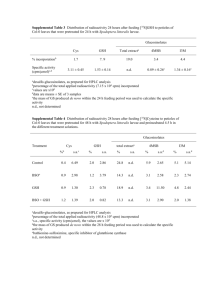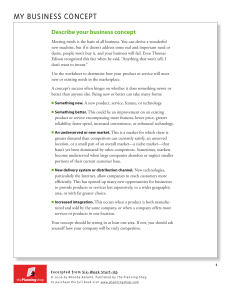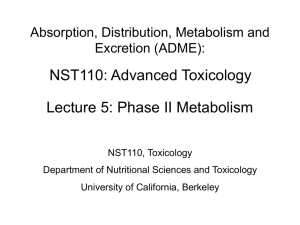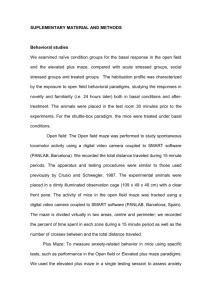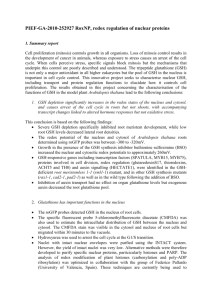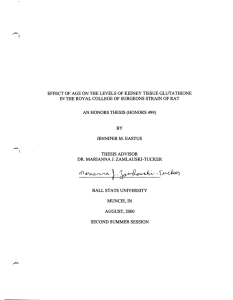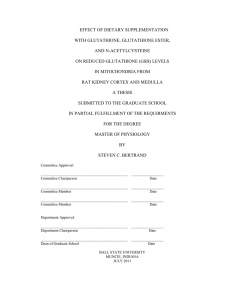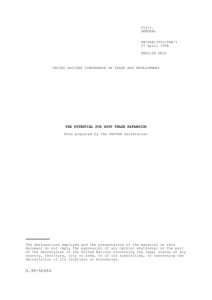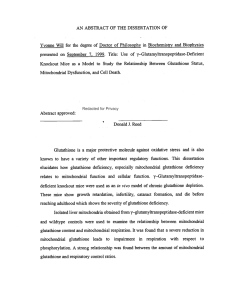GSH
advertisement
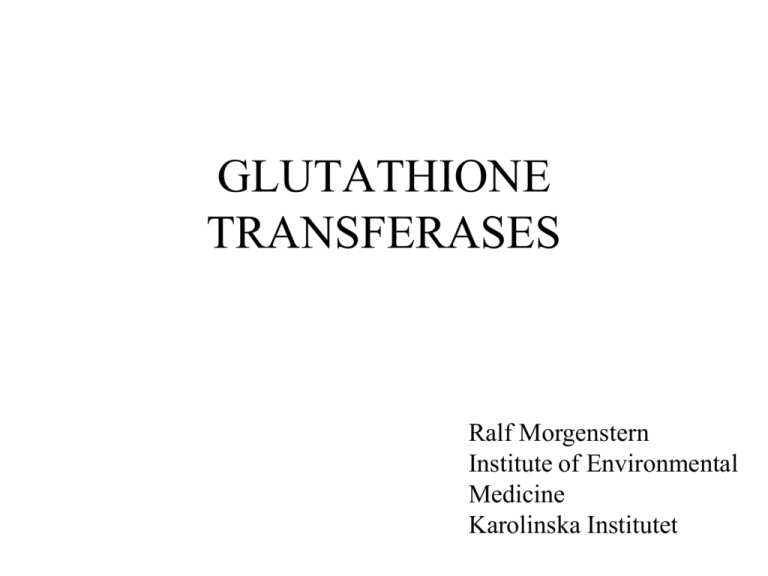
GLUTATHIONE TRANSFERASES Ralf Morgenstern Institute of Environmental Medicine Karolinska Institutet Current themes • • • • • • • GSTs and intracellular signalling pathways MAPEG and eicosanoid signalling Redox regulation (Protein S-glutathionylation) Oxidative stress protection Drug resistance in tumors Chemo-prevention Tools for bioengineering THREE SUPERFAMILIES • SOLUBLE GLUTATHIONE-TRANSFERASES (25 kDa, dimers) aerobic organisms • MEMBRANE BOUND GLUTATHIONETRANSFERASEs (17 kDa, trimer) aerobic organisms • FOSFOMYCIN RESISTANCE PROTEIN (Fos A) (16 kDa, dimer) bacterial FOSFOMYCIN RESISTANCE (Fos A) Fosfomycin (antibiotic) • Bacterial (plasmid or chromosomal) • Specific • Fosfomycin is a stable! epoxide that inhibits cell wall-synthesis in bacteria CYTOSOLIC GLUTATHIONE TRANSFERASES • SEVERAL FAMILIES: alfa, mu, pi, theta, sigma, zeta, omega, beta, phi (incl. ≥1) Monomers: Form dimers: Within a family homo- and heterodimers Evolutionary aspects Domain addition Thioredoxin fold Domain insertion GST Theta Mitochondrial GST Kappa Cytosolic GSTs Alpha, Mu, Pi, Sigma, Beta Zeta, Omega, Phi, Tau, Delta, etc Human soluble GSTs Gene family alpha mu theta Genes A1A5 M1M5 1p Chromo- 6p some pi zeta sigma kappa omega T1,T2 P1 Z1 S1 K1 O1 22q 14q 4q 7q 10q 11q Enzyme Nomenclature: GSTP1-1 or GSTA1-2. Tissue-distribution (human) 1, Standard 2, brain 3, heart 4, kidney 5, liver 6, lung 7, pancreas 8, prostate 9, muscle 10, intestine 11, spleen 12, testis Sherratt et al., Biochem. J. (1997) 326, 837 DIMER-STRUCTURE H-site G-site GSH binding Making GSH more reactive GSH GSOH pKaGSH lowered from 9 to ≈ 6 in the enzyme +H+ Arg+ Tyrosine or Serine (backbone amide?) GS- thiolate is 109 times more reactive than the protonated thiol (Thiolate/CDNB ≈ 5 M-1 s-1; Selenolate/CDNB ≈ 23 M-1 s-1) GSH is bound in an Extended Conformation where all possible interactions are used GS- thiolate Tyr-OH An model second substrate and convenient assay Cl GS NO2 NO2 GSH + + NO2 NO2 HCl New fluorogenic substrates GST Ålander et al, Anal. Biochem. (2009) 390, 52. The H-site Multiple Functions Aflatoxin (carcinogen) BCNU (cytostatic) Atrazine (herbicide) Reactive compounds are common in biology • Cyanobacteria: microcystine O COOH N N O O O N CH 2 O N O N Z N N O • Mustard oil: allylisothiocyanate N C X COOHO S GSH N C S SG Reactive compounds are formed continuously in the cell Lipid peroxidation gives rise to: Hydroxyalkenals: Hydroperoxides: Conjugate export and processing • GSH conjugates are exported out of the cell by membrane transporters called MDR (multidrug resistance proteins) • Conjugates are often processed to mercapturic acids before excretion in urine or bile N-Acetylation g-L-Glu-L-Cys-Gly SX L-Cys-Gly g-L-Glu SX L-Cys Gly SX N-Ac-L-Cys SX Knock-outs • GSTP null mice are more susceptible to skin and lung cancer • GSTA4 null mice are more susceptible to bacterial infection and oxidative stress • GSTBeta null bacteria are more susceptible to oxidative stress Genetic variation in human glutathione transferase Mu English Japanese Indian Micronesia Chinese French Scots 45% 48% 35% 100% 58% 43% 62% % of population that are homozygous deleted for the gene. Persons that lack the gene are more susceptible to certain forms of cancer. Drug resistance BCNU (cytostatic drug) Up-regulation of GST seen in many tumours could contribute to resistance GST protection H2O2 is not a substrate for GTSs Yang et al JBC276, 19220 GSTP knockout leads to increased cJun signalling = increased proliferation Stress (H2O2) GSTP GSTP GSTP GSTP P C-Jun GSTP JNK JNK GSTP catalyses protein Sglutathionylation (H2O2 challenge) Tyr 7, and Cys 47/101 Townsend et al JBC 284, 436 GSTP & Prdx6 = GSH Peroxidase Regulation by Induction GLUTATHIONETRANSFERASEACTIVITY in butterfly larvae + endosulfan Cl O Cl CCl 2 Cl S O Cl + endosulfan depends on diet Willov Apple leaves and treatment with leaves chemicals: e.g. DIET Endosulfan (insecticide) O Chemoprevention depends on Nrf2 regulation Reactive compounds Keap -SH Nrf2 GSTs Quinone reductase GSH synthesis Cytosol Glukosinolat O S N C Sulphoraphane Nrf2 S Antioxidant Response Element nuclei Multiple subcellular distribution • MGST1: Endoplasmic reticulum, outer mitochondrial membrane and plasma membrane • Soluble GSTs: Cytosol, mitochondria, nucleus and some forms show affinity for (plasma) membrane(s) GSTP, Cytosolic and more The MAPEG superfamily • MAPEG = Membrane Associated Proteins in Eicosanoid and Glutathione metabolism • Membrane bound glutathione transferases • Prostaglandin E2 synthase • Leukotriene C4 synthase • 5-Lipoxygenase activating protein The MAPEG theme: reactive lipid Oxygenated arachidonic acid Prostaglandin E Leukotrienes Peroxidized lipids Detoxification by Microsomal Glutathione Transferases (MGSTs) 1-3 MGST1 TRIMER 3-D model (3.2 Å) Peroxidized lipid substrates Conjugation of reactive lipid peroxidation products As Glutathione Peroxidases (GPX) Location, location, location.... cGST/GPX1 MGST1 PHGPX4 Cellular protection by MGST1 Viability (%) MTT 120 110 100 90 80 70 60 50 40 30 20 10 0 Sense AS MCF7wt MGST1 Transfected 0 25 50 75 100 125 150 175 200 [HNE] (µM) MGST1 knockout flies display shorter life span Knock-outs Toba & Aigiki, Gene, 253, 179 (2000) SPECIFIC FUNCTIONS Airwaytonus (Asthma) LTC4 LTA4 LTC4S* AA 5-LO FLAP* PGE2 Stimuli PGH2 PGES* *MAPEG members AA COX Fever Pain Inflammation PGE synthase O O O O PGH2 OH Requires GSH O O O HO OH PGE2 Tissue distribution: NARROW PGES MGST1 WIDE NARROW MGST2 MGST3 5-LipoxyLeukotriene genase C4 synthase activating protein GSH-dep. oxidoreductase GST:s Glutathione peroxidases MGST1 activation MGST1 is activated by sulfhydryl reagents SH SH SH SNEM SNEMSNEM N + O O NEM 2 µmol/min mg 30 µmol/min mg At the single cysteine-49 of the homo-trimer (subunits Mr ≈ 17 kDa) Activation does occur under toxic and oxidative stress in vivo! Thiolate anion formation is activated Activation increases the rate of thiolate anion formation (not the chemical step) Activation of MGST1 by reactive intermediates in vivo (2-3 fold) OH Br O O Br O GSH GST O O Br Diethylmaleate (direct) CCl4 P450 • CCl3 + Br- GS Acetaminophen P450 Reactive quinoneimine Spontaneous GS + Thiiranium ion + Br- Activation Mechanisms of MGST1 Activation of MGST1 by S-thiolation In vitro by GSSG GSSG/GSH ratio = 50 at half maximal activation In vivo by hydroperoxide Sies et al, ABB 322, 288 Capacity and throughput CAPACITY: 0.2 mM Glutathione transferase in liver + 5 mM GSH = 25 turnovers empties the liver of GSH (e.g. paracetamol overdose) Theoretically this can happen in less than a second!!!! THROUGHPUT: Humans excrete 0.1 mmol glutathione conjugates per day = Equal to one turnover per enzyme every second day CON CLUSION Glutathione dependent protection has to be highly abundant and efficient to serve as an interception system Glutathione transferases • Highly abundant and diverse protection from reactive electrophiles • New functions in cell signalling and redox processes • Dynamic regulation • Defined chemical transformations of important endogenous mediators and metabolites • Relevance to inflammation, drug development, drug resistance, anti-carcinogenesis, antibiotic resistance and agriculture. Examples of drugs that are conjugated to GSH • Paracetamol (analgesic, antipyretic) • Carbamazepine (analgesic) • Indomethacin (anti-inflammary) Paracetamol O N O Indomethacin The nucleophile substrate Most Aerobic Organisms contain: • mM concentrations of the low molecular weight nucleophile, Glutathione, g-L-Glu-L-Cys-Gly (GSH)
